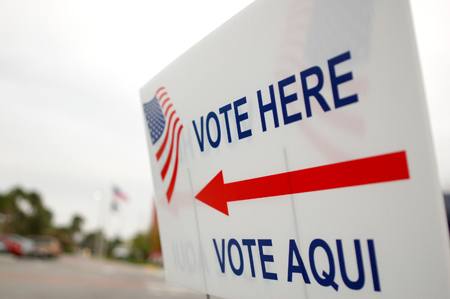
Photo by Erik Hersman used under a Creative Commons License.
There are lots of ways to block people from voting, if that’s your goal. You can prevent them from registering in the first place, you can challenge their registration, you can demand identification they don’t have, you can get in their face when they arrive at the polling place—and even if they do cast a ballot, you can hope their vote doesn’t get counted.
In an era of increasingly aggressive attempts to suppress voting, there are lots of important questions citizens and journalists should be asking in their communities. One question that’s surprisingly easy to answer is: How good is your local election board at making sure every vote is actually counted?
“There are four pieces of data—four metrics—that every local reporter should ask their local election board about and should ride them on because the data could illuminate really extensive problems with voting in your precinct, city, or state,” says Victoria Bassetti, author of the new book, “Electoral Dysfunction: A Survival Manual for American Voters.” (A related documentary of the same name starring Mo Rocca will air on PBS in October.)
“They can show you when votes aren’t being counted, when voters are being unnecessarily turned away, or when ballots are designed in a way that confuses voters,” she said.
1. What’s the residual vote rate?
If 10,000 people walk into a precinct to vote in a presidential election, but only 9,000 votes for president are reported, then it’s a safe bet that 1,000 votes weren’t counted. That scenario would give you an utterly outrageous 10 percent residual vote.
The residual vote rate, then, represents the percentage of intended votes that were not counted for one reason or another. That rate is typically somewhere around 1 percent, although it can vary considerably between states and elections. And it shouldn’t be hard to obtain; some states mandate it. Every election board should be tracking it.
It’s a heck of an indicator. “If you’ve got a high residual vote rate, it’s like a fever,” said Bassetti, a former Senate Judiciary Committee lawyer who has participated in numerous voter rights efforts. “There’s evidence that there’s a virus that’s going through the system and someone needs to get in there and diagnose what’s going wrong and fix it.”
One problem could be poor ballot design. In Florida’s Palm Beach County, for instance, the notorious “butterfly ballot” produced a residual vote rate of over 6 percent in 2000. Precincts with many foreign-born voters can have high residual vote rates, indicating that voting procedures have not been maximized for them.
The Brennan Center for Justice at NYU Law School found that 20,000 votes had been lost in the 2010 New York gubernatorial race because voting machines recorded “overvotes”—the invalid selection of more than one candidate for a single office—and therefore discounted them all. At one precinct in the Bronx, the problem was traced to an overheated scanner.
Whatever the reason, a high residual vote rate “is clear evidence that something is wrong and people need to find out what’s wrong, because people’s votes are being lost,” Bassetti said.
2. Did you find any recount discrepancies?
After the final results are in, election administrators typically conduct an audit of a randomly selected 5 or 10 percent of precincts, recounting the votes to see if the numbers add up, Bassetti said. “It’s like a blood test.”
If voters used paper ballots or electronic machines with a verified paper trail, then election administrators can recount them, and compare totals. (It can’t really be done with purely electronic systems.)
If there are serious discrepancies, that’s another sign of problems.
3. How many provisional ballots were used? And how many counted?
Voters who show up at a polling place but whose eligibility is not sufficiently established can nevertheless be given provisional ballots to fill out.
“If you’ve got a high number of provisional ballots, something has gone terribly wrong with getting information out to voters about where to appear, what they need to have to vote,” said Bassetti. “Or it means that you’ve got pollworkers who are being jackasses.”
Then again, a low number of provisional ballots could mean that the pollworkers aren’t even letting voters fill them out.
Further inquiry is indicated, but the number is a starting point, nonetheless.
Knowing how many of the provisional ballots were ultimately counted is also important. If a high percentage of them are being counted, it tells you the provisional ballot “is actually working—it’s doing what it’s supposed to do, which is salvage the vote,” Bassetti said.
4. What’s your voter registration rejection rate?
As many states approach the deadline for voter registration before the November election, election boards will be flooded with registration forms.
Many will be rejected, for legitimate reasons such as that they were clearly bogus (think “Mickey Mouse”). But election officials should report on how many were accepted, how many were rejected, and for what reasons.
Bassetti said election board officials should be asked not just what their rejection rate was, and what their basis for those rejections was, but also what they did about it? Did they send rejected people a notice? Did they offer those people a chance to fix the problem?
For comparative purposes, the U.S. Election Assistance Commission has some baseline, state-level data on registration and provisional ballots.
There are lots of reasons—some legitimate, some not—that a vote can get lost. Elections are complicated. Ballots can go missing. Volunteer poll workers are poorly trained. Registration lists are faulty. Machines fail. Ballots are confusing. Voter education may have been inadequate. Someone’s fixing the election.
But you won’t know to ask why if you don’t even know there’s a problem.
Dan Froomkin, formerly deputy editor of the Nieman Watchdog website, is a new contributing editor to Nieman Reports. A senior Washington correspondent for The Huffington Post, he previously wrote a White House politics column for The Washington Post’s website.


